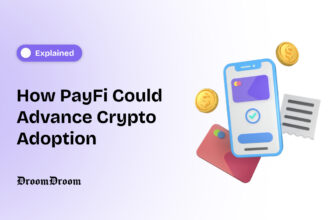Following the creation of Bitcoin, more cryptocurrencies, commonly referred to as altcoins, came to light, and more participants became active in trading the cryptocurrency market. This led to several centralized exchanges (CEXs), making transactions between participants — buyers and sellers- possible. CEXs relied on order books to settle these transactions; however, this came with inherent issues. To solve these problems, automated market makers (AMMs) were created, relying solely on liquidity pools.
You can view liquidity pools as pools of funds. They are smart contracts that enable traders to exchange their coins and tokens, even without buyers or sellers.
Before we go into the details of liquidity pools and their roles in cryptocurrency, we’ll examine some foundational concepts, such as what liquidity is and how it affects financial markets.
What is Liquidity?
Liquidity is how quickly and easily an asset, like a stock or a coin, can be turned into cash without affecting its price. When an asset is hard to sell or buy quickly, it’s called illiquid, and turning it into cash might take longer or cost more.
This comprehensive guide by DroomDroom explains all there is to know about smart contracts in DeFi.
Imagine you’re at the mall wanting to buy ice cream, but there’s a long line of people waiting and only one cashier available. In this case, getting ice cream takes a lot of time, which can be annoying. Now, if several cashiers were open, you could buy your ice cream faster, making the situation much better for everyone. Liquidity is an essential aspect of the cryptocurrency and financial markets.
What Is A Liquidity Pool?
A liquidity pool is a collection of cryptocurrencies locked up in a smart contract and used to generate liquidity to facilitate quicker transactions. It allows cryptocurrency traders to trade tokens on a decentralized exchange (DEX) without the need for centralized order books.
Learn all there is to know on decentralized exchanges in this complete guide by DroomDroom.
Liquidity pools operate using the Automated Market Maker (AMM) protocol, which establishes asset prices and permits automatic trading instead of traditional market-based buying and selling. Before this, during the early days of decentralized finance (DeFi), liquidity was provided through the order book method.
The liquidity of an asset increases as the bid/ask spread reduces and as there are more limited orders in the book. A lower bid or ask gap suggests little price difference between what buyers are ready to pay and what sellers ask. The more limited orders there are, the more traders may be interested in trading the assets at particular prices. It operates similarly to the way the traditional stock market does. If you wish to buy or sell an asset, you simply pick the price you want to buy it at and put it in order. However, in this case, you have to lock the money up in the smart contract.
When the smart contract finds a seller with the same asking price, it links you together, and the transaction is executed (provided you agree to each other’s terms and conditions). The same happens if you want to sell your asset. You must wait until you find someone who matches your buy order. If you can’t wait, you have to look at the whole order book and identify someone who has already made an order; then, you can agree to their terms and conditions and seal the transaction.
This approach was inconvenient because
- You have to keep your assets or funds locked up until someone comes along to buy or sell.
- There is a longer waiting time.
- They were vulnerable to front-running. Users with a faster internet connection could see and execute trades before users with slower internet connections.
So, creating liquidity pools solved the problem of long waiting times or difficulty finding matching orders due to high bid-ask prices and low trading volume. With liquidity pools, you can always trade, regardless of the price, the time of the day, or whether there’s any buyer or seller.
How Does Liquidity Pool Work?
Most liquidity pools follow a 50:50 ratio. For example, let’s say you want to invest $2000 in a BTC-USDT pair on Sushiswap; you’ll need to supply $1000 worth of BTC and $1000 worth of USDT. This ratio is maintained at all times. If more people are buying BTC with USDT, the algorithm increases the price of BTC. This happens because there’s more USDT in the pool, and to keep the ratio balanced, the price must adjust.
AMM (Automated Market Maker) algorithms keep the prices of tokens in a pool close to their market values. These algorithms may vary slightly from one liquidity pool to another. For example, Uniswap and many other decentralized exchanges use a constant product formula to maintain price ratios. This formula adjusts the prices and ratios of tokens in the pool to ensure it can always provide liquidity to the market.
Liquidity pools also incentivize their contributors, known as Liquidity Providers (LPs), to deposit their digital assets. LPs are rewarded with the DEX’s native tokens and a share of the transaction fees generated from the trades. These rewards are distributed periodically and reflect the amount of liquidity each LP has provided.
The Importance of Liquidity Pools
In traditional finance, to complete a trade, you need to find a buyer for the cryptocurrency you’re selling or a seller for what you’re looking to buy. Unlike decentralized exchanges (DEXs), trades happen automatically using a pool of funds that are always there — the liquidity pool.
Liquidity pools are great for DeFi because they don’t need to match a trade at an exact price. If the final price differs from expected — maybe higher — the buyer has fewer tokens, and the seller gets more. This difference is known as slippage.
Transactions come with a small fee to compensate for any losses from slippage. This fee is shared among those who provide the liquidity based on how much they’ve deposited into the pool. Many parts of blockchain-based systems, like borrowing and lending, earning returns from holding cryptocurrencies (yield farming), insuring against risks on the chain, and even blockchain games, all depend on these liquidity pools.
Popular DeFi liquidity Pools
Decentralized exchanges (DEXs) use automated market makers (AMMs) to allow people to trade digital assets automatically and without permission. Here’s a list of some of these platforms:
Uniswap
Uniswap is the largest DEX for Ethereum (ETH), with a Total Value Locked (TVL) of over $4 billion. It’s a popular choice for trading ETH and ERC-20 tokens because it offers high liquidity and low slippage. Uniswap supports blockchains like the BNB Smart Chain, Arbitrum, Optimism, Polygon, and Celo.
Learn all there is to know about total value locked in cryptocurrency.
Uniswap has its governance token called UNI. If you hold UNI tokens, you can vote on certain core decisions that contribute to the platform’s growth, and you’re free to buy, sell, and trade these tokens just like any other. It’s relatively straightforward to become a liquidity provider on Uniswap; you just need a non-custodial wallet such as Coinbase or Metamask. As an open-source platform, Uniswap allows anyone to create a new exchange pair on its network at no cost.
Pancake Swap
PancakeSwap is renowned on the BNB Smart Chain, which allows traders to exchange BEP-20 tokens using non-custodial wallets like Trust Wallet. It’s a highly successful DEX supporting Ether (ETH) transactions. To earn on the platform, users can stake assets, participate in yield farming, and provide liquidity.
The platform’s native governance token is CAKE, primarily used to incentivize users to provide liquidity to the exchange beyond its governance functions.
Balancer
Balancer sets itself apart from other automated market makers by offering ‘balancer pools,’ which can be likened to index funds in that they allow up to eight different cryptocurrencies in a single liquidity pool. This diversification is an advantage for liquidity providers who want to minimize the risk of impermanent loss when depositing their assets. Balancer provides various types of pools, including private and shared options, each with specific benefits for liquidity providers.
In this article by DroomDroom, you’ll find all you need to know about impermanent loss in DeFi.
BAL is the native token of Balancer. It can be traded, sold, or acquired as a reward for providing liquidity to the platform’s pools.
Curve Finance
Curve Finance is a decentralized exchange (DEX) and automated market maker (AMM) known for trading stablecoin with minimal slippage.
The platform supports a wide range of stablecoins, such as USDT, USDC, TUSD, and BUSD, all on the Ethereum blockchain. Curve provides opportunities for traders to participate in DeFi activities like yield farming and liquidity mining with reduced risk.
Conclusion
In the early days of decentralized finance, DEXs faced the challenge of providing sufficient liquidity, a problem traditionally addressed by matching buyers and sellers in an order book.
By offering users incentives to generate liquidity rather than requiring a seller and buyer match in an order book, liquidity pools solved this liquidity problem. This enabled the DeFi industry to thrive by offering a comprehensive, decentralized solution to the liquidity problem.
Although liquidity pools may have developed out of need, their ingenuity has given rise to a brand-new method for decentralizing liquidity through user-funded, incentive-driven asset pair pools.
Frequently Asked Questions
What is Slippage and How Do Liquidity Pools Handle It?
Spillage is when a trade to buy or sell a token is executed at a different price than the expected price. This usually, in most cases, leads to loss. You’ll receive fewer tokens when a trade is executed at a higher price. Conversely, you receive more tokens if the trade is at a lower price. To avoid situations like this, liquidity pools are constantly adjusting the amount of tokens on every trade.
Where Can the Liquidity Pool be Found?
If you are interested in several cryptocurrency or DeFi platforms, including Uniswap, Pancake Swap, Balancer, and Curve, you’ll come across a liquidity pool. You should also know that each of these platform’s liquidity pools operates differently based on the role of the smart contract and the platform itself. However, decisions on these platforms can be influenced by using their governance tokens.
What Risks Are Associated With Providing Liquidity?
Several risks are associated with being a liquidity provider (LP) for a liquidity pool; the most common is impermanent loss. This occurs when the value of a deposited asset changes compared to what’s deposited in the pool; it simply means that LPs would have been more profitable holding the asset than depositing it into a liquidity pool. This is why understanding the overall market condition is helpful.
Can Anyone Become a Liquidity Provider?
Yes, anyone can become a liquidity provider. However, there are some things you need to know. You will need a wallet and the token for the liquidity pool you’ll deposit into. Once settled, you can proceed to become an LP on the platform of best fit, following intense research, of course.
How Do Liquidity Pools Maintain Asset Ratios?
To achieve this, liquidity pools maintain a constant asset ratio (usually 50:50) and adjust the prices of assets within the pool using AMM algorithms based on supply and demand. This ensures a balanced pool and fair market values for the traded tokens. This way, there isn’t much price difference between the pool assets and other DeFi platforms.



















